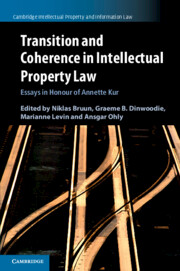Book contents
- Transition and Coherence in Intellectual Property Law
- Cambridge Intellectual Property and Information Law
- Transition and Coherence in Intellectual Property Law
- Copyright page
- Contents
- Preface
- Greetings to Annette Kur from the Second Floor
- Annette Kur: Toward Understanding
- Part I Transition
- Part II Coherence
- A Intellectual “Property” and its Limits
- B IP Overlaps
- 25 Intellectual Property in Transition: The Several Sides of Overlapping Copyright and Trademark Protection
- 26 Cultural Heritage and the Public Domain: What the US’s Myriad and Mayo can Teach Oslo’s Angry Boy
- 27 Public Order in the Light of Aesthetic Theory: The Copyright/Trademark Interface after Vigeland
- 28 Separability as Channeling: A Cautionary Tale
- 29 Novelty, Idea or New Meaning as Criteria for Copyright Protection? Transitions in Swedish Design Law
- 30 Examining Functionality
- 31 Substantial Value and the Concept of Shapes
- 32 Copyright and Patents on Software: The UPC’s Answer to an Old Problem of Intellectual Property Overlaps
- 33 Chopping off Hydra’s Heads: Spare Parts in EU Design and Trade Mark Law
- C (Un-)fairness
- Conclusion
- Cambridge Intellectual Property and Information Law
27 - Public Order in the Light of Aesthetic Theory: The Copyright/Trademark Interface after Vigeland
from B - IP Overlaps
Published online by Cambridge University Press: 29 December 2020
- Transition and Coherence in Intellectual Property Law
- Cambridge Intellectual Property and Information Law
- Transition and Coherence in Intellectual Property Law
- Copyright page
- Contents
- Preface
- Greetings to Annette Kur from the Second Floor
- Annette Kur: Toward Understanding
- Part I Transition
- Part II Coherence
- A Intellectual “Property” and its Limits
- B IP Overlaps
- 25 Intellectual Property in Transition: The Several Sides of Overlapping Copyright and Trademark Protection
- 26 Cultural Heritage and the Public Domain: What the US’s Myriad and Mayo can Teach Oslo’s Angry Boy
- 27 Public Order in the Light of Aesthetic Theory: The Copyright/Trademark Interface after Vigeland
- 28 Separability as Channeling: A Cautionary Tale
- 29 Novelty, Idea or New Meaning as Criteria for Copyright Protection? Transitions in Swedish Design Law
- 30 Examining Functionality
- 31 Substantial Value and the Concept of Shapes
- 32 Copyright and Patents on Software: The UPC’s Answer to an Old Problem of Intellectual Property Overlaps
- 33 Chopping off Hydra’s Heads: Spare Parts in EU Design and Trade Mark Law
- C (Un-)fairness
- Conclusion
- Cambridge Intellectual Property and Information Law
Summary
Annette Kur’s publications on the coherence of the intellectual property system are an incessant source of inspiration for further research and critical reflection. In one of her landmark essays on overlapping intellectual property rights, she develops a general framework for the assessment of cumulative protection. According to this framework, the combination of different intellectual property rights is not problematic per se. In principle, the cumulation of rights is acceptable as long as the individual protection regimes involved are balanced in the sense that the prerequisites for obtaining protection are appropriately aligned with the contents and limits of exclusive rights.2 From this perspective, it is not the cumulation of rights that causes overprotection problems. By contrast, these problems are symptoms of imbalances within the protection systems involved.3 If the prerequisites for obtaining different types of intellectual property rights remain distinct from each other, and the checks and balances in the different protection regimes are sufficient to prevent excessive protection, the overlap is unlikely to obstruct competition and should be deemed permissible.4 If, however, the requirements for obtaining protection in different regimes converge while the contents and limits of protection remain unchanged, overlapping protection raises the problem of “asymmetric convergence” and requires appropriate countermeasures.5
- Type
- Chapter
- Information
- Transition and Coherence in Intellectual Property LawEssays in Honour of Annette Kur, pp. 332 - 343Publisher: Cambridge University PressPrint publication year: 2021

